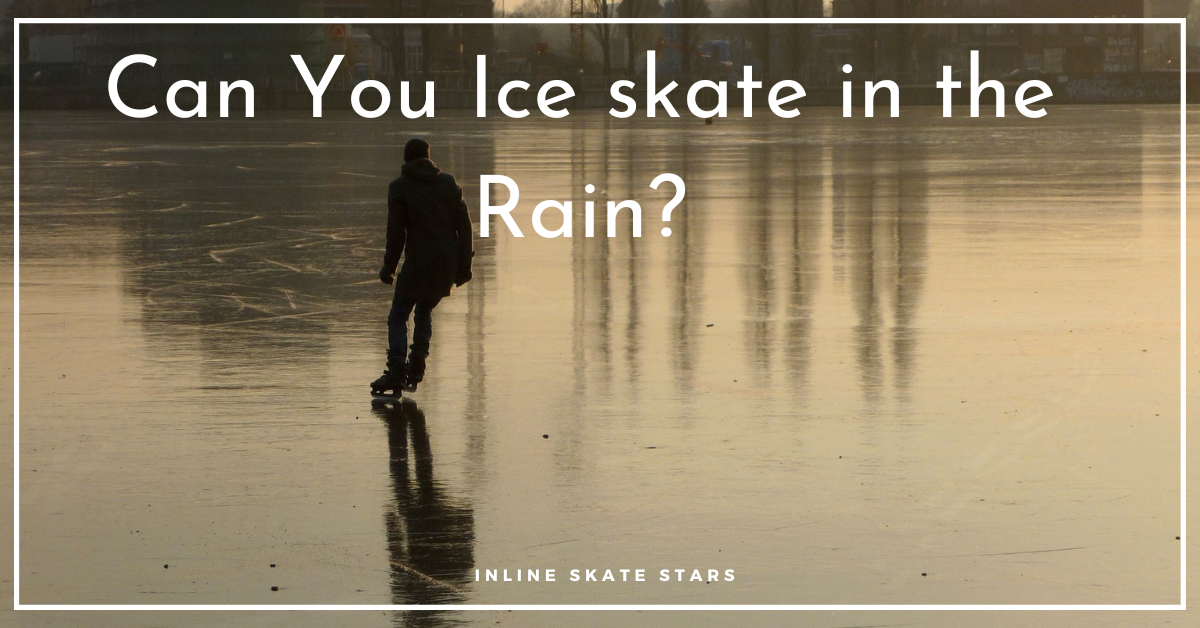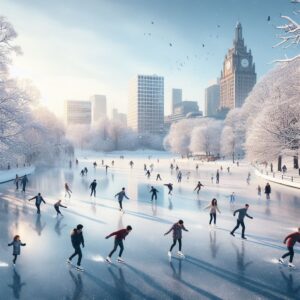Can you ice skate in the Rain? There’s something about ice skating in the Rain that feels exhilarating.
Whether it’s the excitement of trying something new or the sense of community that comes with being out in the cold, ice skating in the Rain is a great way to enjoy the late January winter weather or Christmas.
Though ice skating in the Rain may seem like a great idea, there are risks and challenges that you need to know about.
In this blog post, I’ll discuss whether ice skaters can ice skate in the Rain and the risks and challenges.
I’ll also provide tips on how to ice skate safely in the Rain.
Can you ice skate in the Rain?
Can you ice skate in the Rain? You can no doubt ice skate in the Rain, though it’s not a good idea sometimes, especially when ice skating on frozen ponds, rivers, or lakes.
They might cave in because of increased warmth on the ice, putting your life in danger.
Other risks and challenges associated with ice skating in the Rain, whether on natural or artificial ice rinks, include;
- Slippery surfaces increase the chances of falling and hurting yourself.
- Stopping is a hassle.
- Increased risk of hypothermia.
- Water can damage your ice skate blades.
Also Read>> How to Freeze a Pond for Ice Skating
What are the Risks and Challenges of Ice skating in the Rain?
Below I elaborate on each challenge and risk to help you make an informed decision!
1. Frozen Ponds or Lakes Can Cave in While Skating
Frozen ponds and lakes can easily cave in while skating, putting your life at risk.
When ice skaters skate on a frozen pond or lake, the added warmth from rainwater causes the ice to melt faster than it would normally–according to a NewScientist report.
The biggest risk is drowning especially when skating in a deep lake, river, or pond without adequate swimming skills.
2. Slippery Surfaces Increase the Chances of Falling and Hurting Yourself
Slippery surfaces increase the chances of falling and hurting yourself.
Falling increases your risk of getting injured and can be costly, not just in terms of time lost from work or school but also financially–medical expenses are common.
According to the National Library of Medicine, possible fall injuries include fractures, abrasions, and sprains.
You may hurt your foot or ankle if you fall while ice skating on slippery ice.
If you’re wondering if you can break your ankles ice skating, I did a complete article answering that. Use the above link to read the article.
3. Stopping is a Hassle
Stopping can be a hassle when ice skating, especially when the surface is more slippery because of rainwater.
The primary ice skating-stopping technique, like snowplow and T-stop, is usually hard to pull off because you risk falling because of little to no friction.
If you fall on the water, you risk hurting yourself or drenching your clothes.
I did a complete article about how to stop when ice skating for beginners. You can check it out here. Use the link above.
4. Increased Risk of Hypothermia
Hypothermia is a serious risk when ice skating in the Rain.
According to a WebMD report, unsheltered people who are wet and cold have an increased chance of becoming hypothermic–a condition in which your body temperature falls below 95 degrees F (35 degrees C).
If you become hypothermic, it can cause difficulty breathing, lightheadedness or fainting, seizures, and even death.
5. Water can Damage Your Ice Skate Blades
Water can damage your ice skate blades if it gets inside the ice rink and onto the blades.
The water can cause rust and corrosion, which will weaken the blade.
This could result in a break or fracture of the blade when you skate on it.
The consequence is that you’ll have to budget for new blades or new ice skates when the situation is beyond your control.
Tips for ice skating in the Rain
Ice skating in the Rain isn’t as treacherous as it seems. With a few tips and tricks, you can easily ice skate in any weather condition.
- Before you even hit the ice, make sure you’re dressed appropriately. Wear water-resistant clothes, and don’t wear heavy clothes that will make you sink faster. You can read this article about what to wear when ice skating if you aren’t sure what clothes you should wear.
- Once you’re out on the ice, skate slowly at first to prevent falls. Once you’re more confident, increase your speed.
- And finally, be sure to avoid frozen ponds, lakes, or rivers with thin ice.
Can You Ice Skate in the Rain? FAQs
Can you ice skate when it’s above freezing?
Yes, you can ice skate when it’s above freezing. However, the ice may not be as thick and stable as below-freezing.
Is it safe to ice skate in light Rain?
Light Rain is generally safe to ice skate in if you take precautions.
Ensure you stay on the ice rink’s surface and avoid wetting your feet or hands.
If it’s raining hard, it might be safer to stick to indoor skating until conditions improve.
Would skating in the rain damage my skates?
If you ice skate in the Rain, it’s possible that your skates will get wet and damaged. If this happens, you’ll need to replace your skates.
Can You Ice Skate in the Rain? Wrapping Up
In summary, ice skating in the Rain is generally safe, provided you take precautions.
Be sure to dress appropriately for weather conditions, avoid skating on thin ice, and moderate your speed.
If it’s raining hard, stick to indoor skating until conditions improve.




